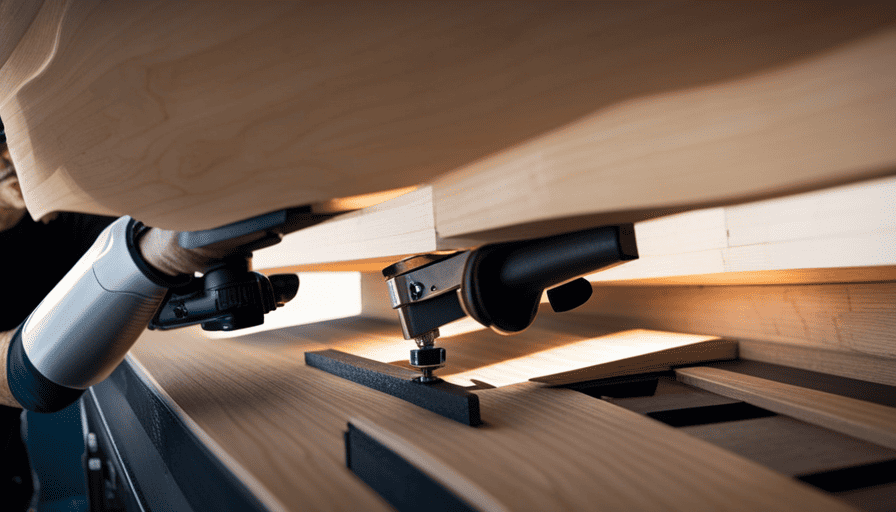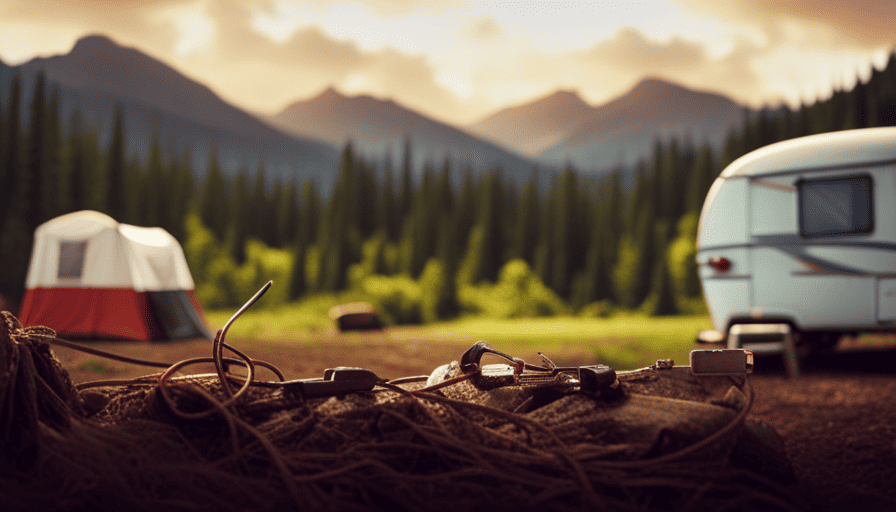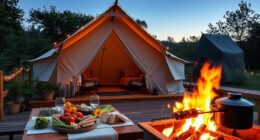As the adage suggests, ‘A home away from home.’ For numerous lovers of the great outdoors, a camper shell represents exactly that – a comfortable haven on the move. Whether setting out on a nationwide journey or just looking for a brief getaway, a camper shell offers the ideal option for both comfort and convenience while camping.
But how much does a camper shell actually cost? In this article, I will guide you through the various factors to consider when determining the price of a camper shell. From different types and sizes to material quality and additional features, understanding these factors will help you make an informed decision.
We’ll also explore the pros and cons of buying second-hand versus brand new, as well as considerations for installation, maintenance, and repairs. So, if you’re ready to hit the road in style, let’s dive into the world of camper shells and discover just how much they truly cost.
Key Takeaways
- The cost of a camper shell depends on factors like type, size, material quality, and additional features.
- Fiberglass shells offer better insulation while aluminum shells are known for their strength and affordability.
- Camper shell installation should match the dimensions of the truck bed and can be a DIY project or done professionally.
- Comparing prices from different retailers is important to find the best deal without compromising on quality.
Different Types of Camper Shells
You’ll be amazed at the variety of camper shells available for you to choose from! When it comes to camper shell materials, you have several options.
Fiberglass shells are popular because they’re lightweight and durable. They also offer better insulation, which can help keep your camping experience comfortable in any weather.
Another option is aluminum shells, which are known for their strength and ability to withstand harsh conditions. These shells are often more affordable, making them a great choice for budget-conscious campers.
Now, let’s talk about camper shell installation. Most shells are designed to fit specific truck models, so it’s important to choose one that matches your vehicle. Installing a camper shell can be a DIY project if you have the right tools and skills, but it’s always a good idea to consult the manufacturer’s instructions or seek professional help to ensure proper installation.
Consider the size and fit of the camper shell for your truck. It’s essential to choose a shell that matches the dimensions of your truck bed. A well-fitted shell not only looks better but also provides better protection from the elements.
With all these options and considerations in mind, you’ll be well on your way to finding the perfect camper shell for your truck!
Consider the Size and Fit
Make sure you find the perfect fit for your vehicle to enhance its functionality and style. When considering the size and fit of a camper shell, it’s crucial to choose one that matches your vehicle’s dimensions.
A camper shell that is too small or too big can cause problems and hinder the overall functionality of your vehicle. To avoid this, take accurate measurements of your truck bed and consult with a professional to determine the right size for your camper shell.
Once you’ve determined the appropriate size, it’s time to think about the installation cost and customization options. Installation costs can vary depending on the complexity of the installation process and the specific features you want. It’s essential to consider your budget and choose a camper shell that fits within your financial means.
Additionally, customization options allow you to tailor the camper shell to your specific needs and preferences. Whether you need additional windows, storage compartments, or specialized racks, there are various customization options available to enhance the functionality of your camper shell.
Considering the installation cost and customization options will ensure that you get the most out of your camper shell.
Now, let’s delve into the next section, which focuses on material quality and durability.
Material Quality and Durability
Ensuring the longevity and strength of your camper shell is crucial for a worry-free and durable outdoor adventure. When considering camper shells, it’s important to evaluate the material quality and durability. Here are some factors to consider:
-
Durability testing: Look for camper shells that’ve undergone rigorous testing to ensure they can withstand various weather conditions and rough terrains. This will give you peace of mind knowing that your shell can handle any adventure.
-
Material cost analysis: Consider the cost of the materials used in the construction of the camper shell. Higher quality materials may come at a higher price, but they’re likely to be more durable and long-lasting. It’s worth investing in a camper shell made from materials that can withstand the elements and provide reliable protection.
-
Construction techniques: Pay attention to the construction techniques used in the camper shell. Welded seams and reinforced corners can contribute to its durability and strength.
-
Maintenance requirements: Consider the maintenance required to keep the camper shell in good condition. Some materials may require more upkeep than others, so choose one that fits your lifestyle and maintenance preferences.
-
Warranty: Check if the camper shell comes with a warranty. A good warranty indicates that the manufacturer stands behind the durability and quality of their product.
By considering these factors, you can select a camper shell that offers the durability and strength necessary for your outdoor adventures.
In the next section, we’ll discuss additional features and accessories to enhance your camping experience.
Additional Features and Accessories
When it comes to camper shells, additional features and accessories can greatly enhance the functionality and convenience of your setup.
One important aspect to consider is the windows and ventilation options. Good airflow is crucial for a comfortable camping experience, so having well-placed windows and vents can make a big difference.
Another key feature to look for is the locking mechanism. It’s essential to have a reliable and secure way to lock your camper shell, ensuring the safety of your belongings.
Lastly, roof racks and ladders can provide additional storage space and easy access to your gear, making it easier to bring along all the essentials for your outdoor adventures.
Windows and Ventilation
Although camper shells vary in price, it’s important to consider the options available for windows and ventilation. When it comes to windows, maintenance is crucial. Look for camper shells with windows that are easy to clean and maintain, as this will save you time and effort in the long run.
Additionally, consider the ventilation options offered by different camper shell models. Some shells come with built-in vents that allow for airflow, reducing condensation and keeping the interior fresh. Others may offer the option to add additional ventilation features, such as roof vents or side windows that can be opened. These options ensure proper air circulation, making your camping experience more comfortable.
Moving on to the next section about locking mechanisms…
Locking Mechanisms
One key aspect to consider is the type of locking mechanisms available, which can provide added security and peace of mind during your camping adventures. When it comes to camper shells, there are various locking mechanisms to choose from. These mechanisms not only secure your belongings but also protect against theft. Let’s take a look at a table that showcases some common locking mechanisms and their features:
| Locking Mechanism | Description | Installation Cost | Security Features |
|---|---|---|---|
| Keyed Locks | Requires a key to open and close the shell. | Low | Provides basic security. |
| Combination Locks | Uses a numerical code to unlock the shell. | Medium | Offers convenience and security. |
| Remote Locks | Operated by a remote control. | High | Provides advanced security features. |
Investing in a reliable locking mechanism is essential to safeguard your belongings while camping. Moving on to the next topic of roof racks and ladders…
Roof Racks and Ladders
Roof racks and ladders are essential additions to elevate your camping experience and make it easier to transport your gear. When it comes to roof rack installation, there are various options available depending on your camper shell’s design. Some roof racks require drilling into the shell, while others use clamps or brackets for a more secure fit. Consider the weight capacity of the roof rack and whether it can accommodate your specific needs.
Additionally, ladder options are important for easy access to the roof of your camper shell. Look for ladders that are sturdy, lightweight, and easy to install. Some ladders even fold or telescope for compact storage. These additions not only enhance the functionality of your camper shell but also provide convenience and versatility.
Moving on to brand reputation and customer reviews, let’s dive into how these factors can help you make informed decisions.
Brand Reputation and Customer Reviews
Hey there! Have you heard about the reputation and customer reviews of different camper shell brands? When it comes to purchasing a camper shell, it’s important to consider the brand reputation and customer satisfaction. After all, you want to invest in a product that’s reliable and meets your needs.
Several camper shell brands have established a strong reputation in the market. These brands have consistently delivered high-quality products and have received positive feedback from their customers. By choosing a reputable brand, you can have peace of mind knowing that you’re getting a product that’s built to last.
Customer reviews also play a crucial role in determining the quality of a camper shell. By reading reviews from other customers, you can gain insights into the pros and cons of different brands and models. Pay attention to reviews that highlight durability, ease of installation, and overall customer satisfaction.
Now that you have an idea of the brand reputation and customer reviews, the next step is to compare prices from different retailers. It’s important to find the best deal without compromising on quality. So, let’s dive into the next section and explore how much camper shells cost at different retailers.
Comparing Prices from Different Retailers
Now that we have a glimpse into the brand reputation and customer reviews, let’s explore how retailers price these essential additions for your adventure on wheels.
When comparing prices for camper shells, it’s important to consider the following factors:
-
Retailer Discounts: Some retailers may offer special discounts or promotions on camper shells, so it’s worth checking different websites or visiting stores to find the best deal.
-
Material Quality: Camper shells can be made from different materials, such as fiberglass or aluminum. The price may vary depending on the material used, with fiberglass generally being more expensive.
-
Size and Compatibility: The price of a camper shell can also depend on the size and compatibility with your specific vehicle. Larger or custom-fit shells may be priced higher than standard-sized options.
-
Customization Options: Some retailers may offer additional customization options, such as windows, roof racks, or interior features. These added features can affect the overall price of the camper shell.
Considering these factors will help you make an informed decision when comparing prices from different retailers.
Next, we’ll delve into installation considerations to ensure a smooth and hassle-free process.
Installation Considerations
When considering the installation of a camper shell, there are several key points to take into account. Firstly, one must decide between DIY installation or professional installation.
Secondly, it’s important to ensure compatibility with the truck bed liners, as not all camper shells are designed to fit with all types of liners.
Lastly, potential modifications may be required depending on the specific truck and camper shell combination.
DIY vs. Professional Installation
Installing a camper shell yourself can save you money, but hiring a professional ensures a seamless and expertly done job. There are a few factors to consider when deciding between DIY and professional installation.
-
Skill level: DIY installation requires some technical knowledge and experience in working with vehicles. If you’re not confident in your abilities, it’s best to leave it to the professionals.
-
Time commitment: Installing a camper shell can be time-consuming, especially if you’re not familiar with the process. Hiring a professional can save you valuable time and ensure the job is done efficiently.
-
Warranty: Professional installation often comes with a warranty, providing peace of mind in case any issues arise.
-
Second hand vs. brand new: If you’re purchasing a used camper shell, professional installation can help ensure compatibility and proper fit.
Considering these factors, it’s important to weigh the pros and cons before making a decision.
Moving on to compatibility with truck bed liners…
Compatibility with Truck Bed Liners
To ensure a seamless fit, you’ll want to consider the compatibility of your truck bed liner with the camper shell you choose. Some truck bed liners may require modifications or may not be compatible at all with certain camper shell models.
Before purchasing a camper shell, it’s important to check with the manufacturer or a professional installer to determine if your specific truck bed liner is compatible. This will save you time and money in the long run, as you won’t have to deal with the hassle of trying to make incompatible parts fit together.
Additionally, it’s worth noting that the installation process may vary depending on the compatibility of your truck bed liner. Potential modifications required may include trimming or removing parts of the liner to ensure a proper fit.
Potential Modifications Required
Some truck bed liners may need modifications or adjustments to ensure a perfect fit with the chosen camper shell, saving you time and money in the long run.
It’s important to note that not all truck bed liners are compatible with all camper shells, and certain modifications may be necessary to achieve a proper fit. The potential costs of these modifications can vary depending on the specific truck and camper shell combination. In some cases, you may need to purchase additional parts or hire a professional to make the necessary adjustments.
Additionally, you may require specific tools to complete the modifications, such as a drill or a saw. Taking these potential costs and necessary tools into consideration can help you budget appropriately for your camper shell installation.
Moving forward to the next section about maintenance and repairs, it’s important to properly care for your camper shell to ensure its longevity.
Maintenance and Repairs
When it comes to maintenance and repairs for camper shells, there are a few key points to keep in mind.
First, it’s important to know how to properly clean and care for your camper shell to keep it in good condition.
Additionally, being aware of common issues and troubleshooting methods can help you address any problems that may arise.
Lastly, understanding the warranty coverage for repairs can provide peace of mind in case any major repairs are needed.
Cleaning and Care Tips
Maintaining and cleaning your camper shell is essential to prolong its lifespan and ensure it remains in top condition, as neglecting regular care can result in a 30% decrease in its durability. To keep your camper shell clean and free from mold and mildew, here are three cleaning techniques you can use:
-
Regularly wash the exterior of the camper shell with mild soap and water to remove dirt, grime, and any potential mold spores.
-
Use a mold and mildew remover specifically designed for camper shells to eliminate any existing mold or mildew growth.
-
Ensure proper ventilation by opening windows or using a dehumidifier inside the camper shell to prevent moisture buildup.
By following these cleaning techniques, you can maintain a clean and mold-free camper shell. However, if you do encounter any common issues or need troubleshooting assistance, the next section will provide you with helpful solutions.
Now let’s move on to common issues and troubleshooting.
Common Issues and Troubleshooting
Let’s dive into the common issues and troubleshooting tips to ensure your camper shell remains in top condition!
One common issue that camper shell owners face is improper installation. It’s important to follow the installation instructions carefully to avoid any problems down the line.
Another consideration is choosing the right color for your camper shell. While this may seem like a minor detail, it can make a big difference in the overall appearance of your vehicle. Make sure to choose a color that complements your truck’s exterior.
If you encounter any issues or have questions, it’s always a good idea to consult the manufacturer’s guidelines or contact a professional for assistance.
By addressing these common issues and taking the necessary steps to troubleshoot, you can ensure that your camper shell will provide you with years of reliable use.
Now, let’s transition into the subsequent section about warranty coverage for repairs.
Warranty Coverage for Repairs
To ensure you have peace of mind, it’s important to understand the warranty coverage for any repairs needed on your camper shell. Knowing what is covered and what is not can save you from unexpected repair costs. Here is a breakdown of the warranty coverage for common repairs on camper shells:
| Issue | Covered | Not Covered |
|---|---|---|
| Leaks | ✔️ | ❌ |
| Structural | ✔️ | ❌ |
| Paint | ✔️ | ❌ |
| Hardware | ✔️ | ❌ |
| Electrical | ✔️ | ❌ |
As you can see, most warranty coverage includes repairs for leaks, structural issues, paint, hardware, and electrical problems. However, it’s important to carefully review the warranty terms to ensure you are aware of any limitations or exclusions. Understanding the warranty coverage can help you make an informed decision when considering whether to purchase a second-hand camper shell or invest in a brand new one.
Second-hand vs. Brand New
When considering camper shells, it’s important to weigh the pros and cons of buying used versus brand new.
Used shells can often be found at a lower cost, making them a more affordable option for those on a budget. However, it’s crucial to thoroughly inspect the shell for any damage or wear before making a purchase.
A great place to find used camper shells is through online marketplaces, local classified ads, or at camper shell specialty shops.
Pros and Cons of Used Shells
Consider the benefits and drawbacks of opting for a used camper shell: you’ll save money upfront, but you may have to invest more in repairs down the line.
Used camper shells can be a cost-effective option, especially if you’re on a tight budget. They often come at a fraction of the cost of brand new ones, allowing you to allocate more funds towards other aspects of your camping setup. Additionally, installation tips and guides are readily available, making it easier for you to install the shell yourself and save on professional installation costs.
However, keep in mind that used camper shells may have wear and tear, requiring repairs or replacement parts in the future. It’s essential to thoroughly inspect the shell’s condition and ensure it’s compatible with your truck. Considering resale value is also important if you plan on upgrading in the future.
Now, let’s explore where to find used shells.
Where to Find Used Shells
Looking for a bargain? Check out these top spots to snag a pre-loved camper shell! When it comes to finding affordable options, there are a few places you can turn to.
First, consider checking out online marketplaces such as Craigslist, eBay, or Facebook Marketplace. These platforms often have a wide selection of used camper shells at competitive prices.
Another option is to visit local classified ads or check with local dealerships that specialize in camper shells. They may have used options available at a discounted price.
When searching for a used camper shell, it’s important to check for compatibility with your specific truck make and model. This will ensure a proper fit. So, before making a purchase, take note of the dimensions and features of the shell and compare them to your truck’s specifications.
Once you’ve found a potential option, it’s time to move on to inspecting for any damage or wear.
Inspecting for Damage or Wear
Now that you’ve found a potential option, it’s time to take a closer look and see if there’s any wear or tear to beware. When inspecting a camper shell, one of the first things to check for is cracks. Look carefully at the corners and edges of the shell, as these areas are more prone to damage. Cracks can lead to leaks, which can cause water damage to your belongings inside the shell.
It’s important to thoroughly inspect both the interior and exterior of the shell for any signs of damage. Additionally, check the windows and seals to ensure they’re in good condition.
Once you’ve inspected the shell for any potential issues, you can move on to setting a budget and making a purchase.
Setting a Budget and Making a Purchase
When you’re ready to buy a camper shell, picture yourself confidently walking into a store, knowing exactly how much you’re willing to spend. Setting a budget is an important step in the buying process, as it helps you narrow down your options and prevents you from overspending.
Before you start shopping, consider the installation cost of the camper shell. Some stores may offer free installation, while others may charge a fee. It’s important to factor in this cost when determining your budget.
Another important consideration is finding the right size camper shell for your vehicle. Take accurate measurements of your truck bed to ensure you choose a shell that fits properly. A camper shell that is too big or too small will not only look odd, but it may also affect the functionality and security of your truck bed.
To make the most informed decision, here are three helpful tips to keep in mind:
- Research different brands and models to find the best quality and price that fits within your budget.nn2. Compare prices from different stores to ensure you’re getting the best deal.nn3. Consider buying a used camper shell, as it can be a more affordable option without sacrificing quality.
By following these guidelines, you’ll be well-prepared to make a confident purchase within your budget.
Frequently Asked Questions
Are camper shells compatible with all truck models and sizes?
Yes, camper shells are compatible with most truck models and sizes. While it’s true that some truck models may require specific camper shell installations, there are options available for almost every truck on the market.
Installing a camper shell offers numerous benefits, such as added storage space, protection from the elements, and improved fuel efficiency. Whether you have a compact truck or a full-size pickup, there’s likely a camper shell option that’ll suit your needs.
Can camper shells be customized to fit specific needs or preferences?
Yes, camper shells can be customized to fit specific needs and preferences. There are various customizing options available, allowing you to personalize your camper shell according to your requirements.
The benefits of customized camper shells include enhanced storage solutions, improved organization, and increased functionality. By customizing your camper shell, you can create a tailored space that suits your individual needs, making your camping experience more enjoyable and convenient.
How long do camper shells typically last before needing to be replaced?
On average, a well-maintained camper shell can last up to 10 years before needing replacement. When considering how to choose the right camper shell for your truck, there are several factors to consider.
Firstly, think about the intended use of the camper shell and the features you require, such as windows or insulation. Additionally, consider the material, size, and compatibility with your truck model.
By carefully evaluating these factors, you can ensure a long-lasting and suitable camper shell for your needs.
Can camper shells be easily removed and reinstalled on a different truck?
Yes, camper shells can generally be easily removed and reinstalled on a different truck. The removal process typically involves unscrewing the shell from the truck bed and disconnecting any electrical connections. The installation process is usually the reverse, where the shell is aligned and secured onto the new truck bed. However, it’s important to note that the ease of removal and installation may vary depending on the specific make and model of the camper shell and the truck it’s being transferred to.
Are there any special maintenance requirements for camper shells?
Special maintenance is essential for keeping camper shells in top shape. Regular cleaning is necessary to prevent dirt and grime from building up and causing damage.
Additionally, weatherproofing is crucial to protect the shell from the elements. This involves applying a protective sealant to ensure water doesn’t seep in.
By taking these steps, you can prolong the life of your camper shell and enjoy many adventures on the road.
What is the Average Cost of a Camper Van?
The average cost of a camper van varies greatly depending on several factors. Typically, camper van pricing information ranges from around $30,000 for a basic model to well over $100,000 for a luxury version. Factors such as brand, size, features, and customization options heavily influence the final price. It’s important to research different options and consider individual needs before making a purchase.
Conclusion
In conclusion, camper shells come in various types, sizes, and materials, offering different features and accessories. It’s important to consider factors such as brand reputation, customer reviews, and installation requirements before making a purchase.
Maintenance and repairs should also be taken into account, as well as the decision between buying second-hand or brand new. Setting a budget is crucial in ensuring a wise investment.
Interestingly, statistics show that the average cost of a camper shell ranges from $900 to $2500, depending on the type and brand chosen. The cost of installation can also vary, with some retailers offering free installation with the purchase of a camper shell. It’s important to do thorough research and shop around to find the best deal. Many experts recommend the best time to buy a camper is during end-of-season sales when retailers are looking to clear out their inventory and make room for new models. This can be a great opportunity to save money on a high-quality camper shell.










